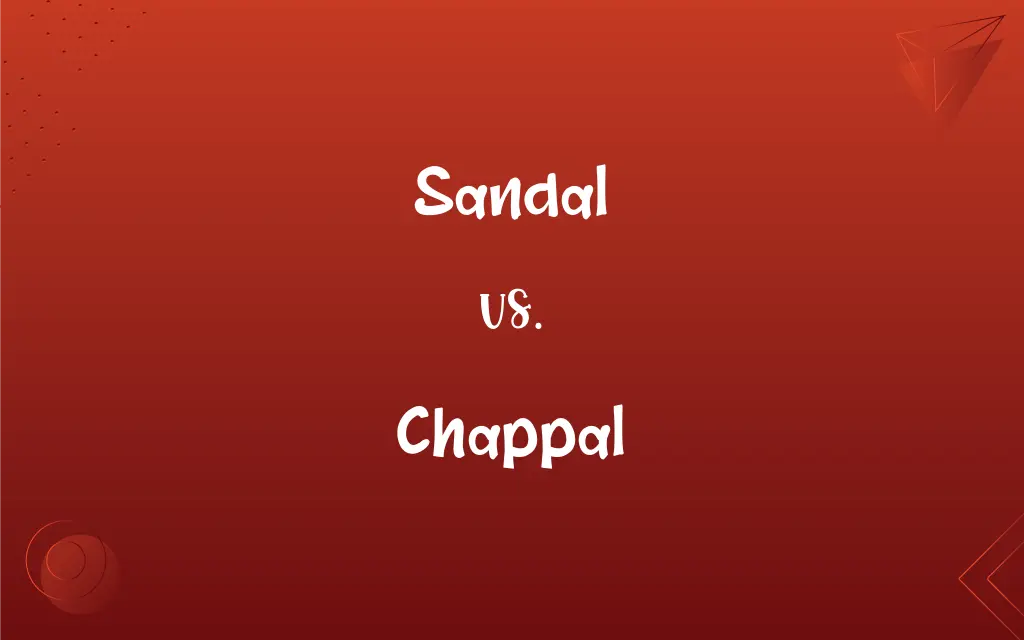Sandal vs. Chappal: What's the Difference?
Edited by Janet White || By Harlon Moss || Published on December 24, 2023
Sandals are open-toe footwear with straps, while chappals, often used in South Asian context, are flat, lightweight, and typically slip-on style.

Key Differences
Sandals are a type of open footwear consisting of a sole held to the wearer's foot by straps or bands. Chappals, prevalent in South Asian countries, are a simpler form of footwear, usually slip-on and without any back support.
Sandals can range from casual to formal, often seen in various designs and materials like leather or rubber. Chappals are generally casual, traditionally made of leather, rubber, or synthetic materials, and used for daily wear.
The design of sandals often includes multiple straps, securing the foot more firmly. Chappals typically have a single strap or a thong design, making them easy to wear and remove.
Sandals are used globally and come in various styles, including those suitable for hiking or fashion. Chappals are more culturally specific, often worn in households or for casual outings in South Asian contexts.
In terms of comfort and functionality, sandals often offer more support and are suited for longer periods of wear. Chappals are more for convenience and short-term use, offering basic foot protection and comfort.
ADVERTISEMENT
Comparison Chart
Design
Open-toe with straps or bands.
Typically slip-on, often without back support.
Usage
Ranges from casual to formal, versatile in use.
Mostly casual, common in household and everyday wear.
Cultural Prevalence
Used globally, with various cultural adaptations.
Predominantly used in South Asian countries.
Material Variety
Made from a wide range of materials like leather, rubber, or synthetic.
Often made of leather, rubber, or synthetic materials, but less variety than sandals.
Foot Support
Generally offers more support and is suitable for extended wear.
More focused on convenience and short-term comfort.
ADVERTISEMENT
Sandal and Chappal Definitions
Sandal
A type of light shoe, suitable for warm weather or indoor use.
He packed a pair of sandals for his summer vacation.
Chappal
A type of sandal predominantly used in Indian subcontinent households.
Their house had a rack filled with different kinds of chappals.
Sandal
Open-toe footwear with straps securing the sole to the foot.
She wore elegant leather sandals to the beach party.
Chappal
Casual footwear, often with a single strap or thong design.
She wore her favorite chappals to the local market.
Sandal
A shoe consisting of a sole fastened by straps over the instep and sometimes the ankle.
She preferred sandals over shoes in the hot weather.
Chappal
A lightweight, flat slip-on footwear, commonly used in South Asia.
He slipped on his chappals before stepping out to the balcony.
Sandal
Footwear with a sole and various straps, worn for comfort and ease.
She chose sandals for her daily walks due to their comfort.
Chappal
Simple, easy-to-wear footwear without back support, used for daily wear.
For indoor use, he always preferred chappals.
Sandal
Versatile footwear that can be casual or formal, with open construction.
For the outdoor wedding, he wore formal sandals.
Chappal
Basic foot protection, often made of rubber or leather, common in South Asian culture.
On his trip to India, he bought a pair of traditional leather chappals.
Sandal
A shoe consisting of a sole fastened to the foot by thongs or straps.
Chappal
A type of footwear used in India, Mauritius, and Pakistan, similar to a sandal.
Sandal
A low-cut shoe fastened to the foot by an ankle strap.
FAQs
Are sandals suitable for hiking?
Special hiking sandals are available, designed for outdoor activities.
Can sandals be formal wear?
Some sandals are designed for formal occasions, often embellished or made with fine materials.
What climates are best for wearing sandals?
Sandals are ideal in warm or tropical climates.
What is a sandal?
A sandal is a light shoe with either an openwork upper or straps attaching the sole to the foot.
Are sandals good for your feet?
They provide comfort and breathability but often lack the support of closed shoes.
Are sandals unisex?
Yes, sandals are worn by all genders.
What materials are sandals made from?
They can be made from leather, rubber, fabric, and synthetic materials.
What materials are used to make chappals?
They are usually made from leather, rubber, or synthetic materials.
Can sandals have heels?
Yes, there are heeled varieties like wedge sandals.
Can chappals be worn in wet conditions?
Rubber or synthetic chappals can be, but leather ones are not suitable for wet conditions.
Are chappals culturally significant?
Yes, in South Asian cultures, they are a traditional form of footwear.
How do sandals differ from flip-flops?
Sandals have more secure straps, while flip-flops are typically a Y-shaped strap.
What is a chappal?
Chappal is a type of footwear similar to a sandal, commonly worn in South Asian countries.
How are chappals different from sandals?
Chappals are typically more minimalistic and functional compared to the decorative and varied designs of sandals.
Can chappals be used for formal occasions?
While typically casual, some ornate designs are suitable for semi-formal occasions.
Can chappals be handcrafted?
Yes, artisanal handcrafted chappals are quite popular and valued for their craftsmanship.
Are sandals ancient footwear?
Yes, they have been worn since ancient times in various cultures.
Are chappals casual wear?
Yes, they are generally considered casual footwear.
Are chappals suitable for all ages?
Yes, they are worn by people of all ages.
Do chappals offer foot support?
They provide basic support but are not designed for extensive walking or support needs.
About Author
Written by
Harlon MossHarlon is a seasoned quality moderator and accomplished content writer for Difference Wiki. An alumnus of the prestigious University of California, he earned his degree in Computer Science. Leveraging his academic background, Harlon brings a meticulous and informed perspective to his work, ensuring content accuracy and excellence.
Edited by
Janet WhiteJanet White has been an esteemed writer and blogger for Difference Wiki. Holding a Master's degree in Science and Medical Journalism from the prestigious Boston University, she has consistently demonstrated her expertise and passion for her field. When she's not immersed in her work, Janet relishes her time exercising, delving into a good book, and cherishing moments with friends and family.
































































